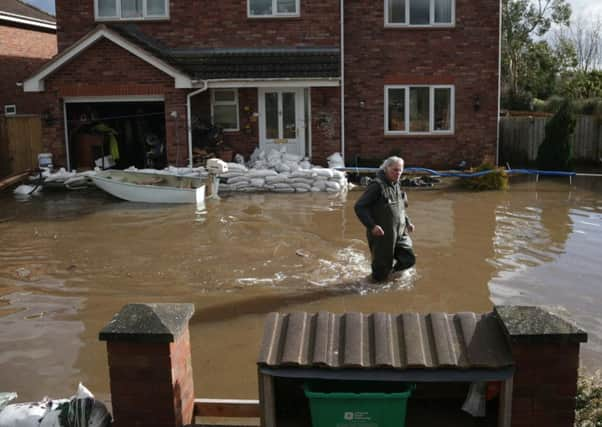Personal finance: Protect your home from flooding


Scots in homes at risk of flooding have been urged to bolster their defences this winter as insurers and the government remain at loggerheads over plans to protect flood-risk properties.
Agreement has yet to be reached on the “Flood re” scheme aimed at keeping premiums affordable for properties hit by flooding, with experts warning that it could be another year before anything is in place.
Advertisement
Hide AdAdvertisement
Hide AdThe scheme will replace the “statement of principles”, the previous deal between insurers and the UK government, that expired in summer 2013.
That arrangement saw insurers guarantee affordable cover for homes seen as being at risk of flooding in return for government investment in flood defences.
As it stands, Flood re will ensure that around 350,000 properties considered at risk of flooding will be protected from hefty premium increases. It will add between £10 and £12 to home insurance premiums and is expected to start next year, with insurers having agreed to extend their guarantee in the interim.
However, it has emerged that insurers and Westminster are still locked in dispute over certain details, such as the types of properties covered and the level of government spending on flood defences.
Insurers have described the current proposals as “unworkable” and warn that under-investment in flood defences makes their current commitment to cover flood-risk properties unsustainable.
In a recent letter to the Chancellor of the Exchequer George Osborne, groups including the Association of British Insurers and the National Flood Forum called for an extra £500 million to be invested in flood protection.
Meanwhile the Independent Committee on Climate Change has predicted that a quarter of a million more UK homes will be at “significant risk” of flooding unless there is greater investment in defences.
Janet Connor, managing director of AA Insurance, said: “The government made an extra £270m available for new flood alleviation schemes following the 2013 storms including £35m for maintaining existing defences over the next two years. But this simply restores maintenance funding to 2010-11 levels.”
Advertisement
Hide AdAdvertisement
Hide AdInsurers paid out nearly £500m to flood-hit homes and businesses in the two months to the end of February this year, with several areas in Scotland affected, including Aberdeenshire, Ayrshire, Argyll and Dumfries and Galloway.
One in 22 homes and one in 14 businesses in Scotland is at risk of flooding, according to the Scottish Environmental Protection Agency (Sepa).
The ABI has estimated that, in the absence of an insurance protection scheme, around 5,000 homes in Scotland would struggle to afford home insurance. That would in turn make it difficult for those homeowners to secure mortgage finance or sell their property in future.
But many could miss out even under the Flood re agreement, which falls a long way short of providing full protection. Buy-to-let homes, properties in council tax band H, houses built after 2009, leaseholds in large blocks, farms and businesses will all be excluded from Flood re, as it stands.
“Questions remain about its final form,” said Connor. “For example, it’s not yet known whether leased homes will be in scope and what conditions would apply if they were included (for example the leaseholder and/or immediate family live in the property); similarly with flats – at present it looks as if buildings with more than three flats would be excluded.”
Millions will be “exposed to rocketing insurance premiums” as a result, the British Property Foundation (BPF) has claimed.
Around 800,000 of the UK’s five million leasehold properties are in flood risk areas, it estimated.
Ian Fletcher, the BPF’s director of policy, said: “Having been campaigning for the inclusion of leasehold properties in Flood re for a while, a repeated source of frustration has been the lack of explanation or evidence for many of the decisions made, and the regulations that have been set out so far do not do much to assuage these.”
Advertisement
Hide AdAdvertisement
Hide AdInsurance premiums for all homeowners would be particularly vulnerable to sharp increases if there were extensive flooding soon after the launch of Flood re.
Conner said: “Prevention, surely, is far better than the huge economic as well as physical damage, to say nothing of the mess and misery of those affected for possibly months after an event, that is inflicted by flood damage: much of the cost of reparation is picked up by insurers which is just part of the wider hidden cost.”
• Get hold of some flood boards and sandbags with which to block your doorways and help stem any flooding.
• Move valuable possessions off the floor and (where relevant) put them upstairs.
• Protect irreplaceable and/or sentimental items (such as photographs) in sealed waterproof bags and place them somewhere safe and dry.
• Make sure that your outside drains aren’t blocked.
• Make a list of useful contacts such as your insurance provider and policy number, and Sepa’s floodline (0845 988 1188).
• Put together an emergency kit containing personal IDs, any necessary medication and a change of clothing.
• Stay up-to-date by keeping a close eye on the weather forecast. Check the Sepa website (www.sepa.org.uk) and the Met Office (www.metoffice.gov.uk).